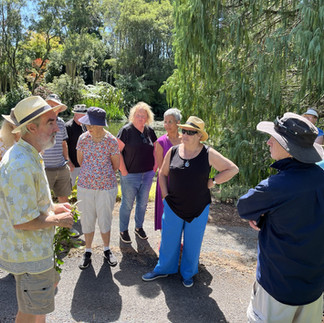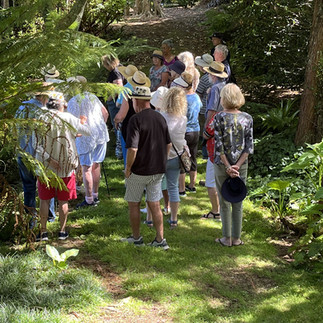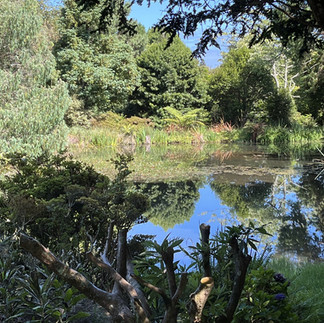Monthly Newsletter -February 2025
- pukekurafriends
- Mar 1
- 9 min read

Events Programme March 2025
March
4th Curator’s Walk.
Meet at the Bellringer Pavilion at 10.30.
18th Wanderers’ walk. Predator Control in the Park - Mark Henderson.
20th Committee meeting.
27th Annual General Meeting. Historic film footage – the establishment, building of
Brooklands Bowl.
Review of February's Events
4th February - Glyn Church's Garden
Tuesday 4th Feb saw 24 wanderers, (plus a very social wee toddler) meet at Glyn & Gael Church’s haven, south of Ōakura, a microclimate area.
It was an entertaining browse thru their 10 acres of plant forest.
I just loved the way Glynn interspersed his walk with numerous anecdotes, and LOGIC of plants evolvement, he seems to have a rapture with them, perhaps a “plant whisperer”?
Fascinating to see, the number of “old fashion” hydrangeas, how they have made an impression on today’s gardeners, and the colours and form, the oak leaf Americans.
The line of staunch phebaliums - apparently they make amazing firewood.
The multi coloured flame lily also drew a lot of attention.
It was a walk when one would later say to a friend “I wish you’d been there”.
18th February - Wanderers' Walk - Lead Tony Burrell
Eastern Hillside
A small group of 8 for the walk. After much needed rain overnight we had fine conditions. First up was viewing the cycads around the Fred Parker lawn area. The most endangered species in the world today are not rhinos or elephants, they are plants called cycads. The Park has a fine collection of cycads from around the world. They are an excellent fit for a Park in being slow growing, long lasting, excellent form, low maintenance and most produce spectacular large cones. They are dioecious which means the male and females are on separate plants. We were shown how to identify a male or female by the different cones.
Cycads distribution is in the tropical and subtropical areas of Asia, Australia, America and Africa. New Zealand fossil records show we had at least three species of cycad around 15 million years ago. They have all died out.
Cycad Pollination
Cycad pollination is very interesting. Cycads evolved around 300 million years ago along with other conifers. Conifers are wind pollinated. The cycads cones are similar to the familiar pine cones which are all wind pollinated. About 150 years ago Joseph Hooker, an English botanist (who spent time in New Zealand) identified that the female cycad cones had more pollen within them than what wind pollination would deliver. He suggested some sort of insect pollination was likely involved. Further research in the early twentieth century confirmed insect pollination was involved. Wind pollination of cone bearing trees was so ingrained that it continued to be believed that cycads were wind pollinated right up to the late twentieth century. Animal assisted pollination was assumed to have developed with the evolution of the flowering trees over 150 million years later. Recent research has shown that beetles pollinate nearly all cycad species, with wind used only as a backstop if the beetles are absent. The scales on most cycad cones are arranged in a spiral pattern. When the pollen inside the male cones is ready for dispersal the cone tends to unwind, allowing gaps for beetles to enter. They breed within the cone and feed off the pollen tissue. Life is really good for the beetles with no incentive to move on. Cycad need the pollen to be transferred to the female cones so they have developed a unique push-pull pollination strategy. The male cone has a cycle where it heats up in a process called thermogenesis, releasing a volatile chemical which repels beetles in high dosage. The beetles load up with pollen for their journey and head out. Female cones which are ready for pollination also unwind and attract the beetles using the same chemical but at a low dosage which attracts beetles. The male cones cycle the thermogenesis so the chemical returns to the low volatile state attracting beetles back again.
As we started climbing around the Eastern hill we were shown the yellow ripe cone of Encephalartos villosus called the poor man’s cycad as it is easy to propagate and cheap to buy. It is a South African species and seeds well in the park. The red coloured seeds are highly poisonous, as is the rest of the plant. It has been said just two seeds will kill a dog. Good reason to tell dog owners to keep their dogs on a leash in the park.
Doryanthes
A bit further on we were shown the two species of Doryanthes which are some of the world’s largest lilies. These develop a long upright stem up to 5m in height with a crimson flower head at the top. The closest one from the path was called Doryanthes palmeri. The weight of the massive flower head causes the high stem to bend over like the wind wand. The other species further up the top was called Doryanthes excelsia. Its tall flower stem was perfectly upright as its flower head was smaller and no doubt a lot lighter. Both lilies are native to the coastal areas of New South Wales.
The flowering was well over during our visit and only the seed capsules remained on top of the stems. The leaves grow in a rosette and are sword shaped up to 3 metres long and around 100mm wide. The leaves are corrugated along their length which adds strength and would also help channel water towards the centre. They do not tolerate frosts. They can take up to 14 years to flower and that rosette will not flower again. A new rosette will take its place. Fortunately the park has a number of Doryanthes so we will be able to witness the spectacular flowering at regular intervals
Kauris
We then viewed some of the overseas kauris in the Agathis genus. This genus is native to Australasia and South East Asia and interestingly our own iconic Kauri name is also used as the common name for all the other overseas species. The two close to our path were native to New Caledonia. The lower one was called Agathis moorei. It was named after Charles Moore, the director of the Sydney botanical garden, who collected specimens during a visit to New Caledonia in 1850. Curiously, due to a mix-up of the type specimens, this tree with lanceolate leaves was named Agathis moorei whilst a tree collected by Moore was named Agathis lanceolata. On the high side of the path was Agathis corbassonii. This species has been revealed to be so similar to Agathis moorei that in 2010 it was included within the moorei species. As with many changes this has not been universally accepted and more research is underway. New Caledonia is an island hotbed of plant diversity. There are 5 named species of Agathis there where we have only one, our mighty Kauri Agathis australis.
Further up the hill we saw Agathis robusta the Queensland kauri. It is native to Queensland and New Guinea. This tree produces a high quality timber which led to it being heavily logged from the mid-19th century, with the result that the large stands of these trees, which were once common, are now gone. Parallels to our own Kauri demise.
We doubled back and continued along the path behind the racecourse, admiring a Matai tree which, after rain, showed the blood red patches from areas where bark flakes had recently separated from the trunk.
Further on we meet a couple from Auckland. The husband was a retired arborist who worked at some of the Auckland parks. He was admiring the health of the trees in our park. We travelled down towards Brooklands, with our Auckland visitors in tow, then ambled back along the lake track to finish the walk at the Kiosk.
27th February - Evening Meeting
Former Cedar Lodge owner David Sampson told us the story of how he and his wife Noeline fell into the business of selling Christmas trees. He had planted a grove of radiata pine for timber production. In September a few years later, he decided to thin them out. Noeline stopped him and suggested that he should wait until December and sell them as Christmas trees. David thought it was bad idea because the trees looked terrible. However, they sold for $5 each which piqued his interest.
Unfortunately growing an ideal Christmas tree proved more difficult that David imagined. He started out by growing the trees from cuttings taken from established trees which didn’t produce the desired shaped trees, so they went to planting seedlings. They tried growing and selling trees in pots which wasn’t popular. He experimented with several kind of trees, some of which had branches which grew up at an acute angle, others were too prickly, others didn’t grow fast enough. In the end he went back to the radiata pine. Another reason for picking radiata pine was the smell. For the majority of trees the growing time was about 30 months. Some trees were grown on longer if clients required larger trees.
He planted the trees in a grid layout with the trees exactly 1.6 metres apart. Grass was grown between the trees which was regularly mown with a ride-on mower. David found this advantageous as he could inspect the trees for problems as he was mowing. Dothistroma was a common issue which he treated with a copper fungicide.
Another aspect of the process is pruning which needs doing at least a couple of times. The last prune is done just before the trees are removed. Having the right shape is important but it is very time consuming.
When they first started selling trees David would cut them down and lead them against the wall in his hay barn. He visited the states and found that over there customers cut down the trees themselves. He was reluctant to do that but when he tried it, it was successful. He said the children enjoyed running around trying to find the best tree.
David ended the talk with a tip for anyone taking a tree home. To keep the tree healthy for as long as possible it needs to be put in water as quickly as possible. As soon as the tree is cut it will start sealing, so when you get the tree home cut off 1cm off the bottom.
Many thanks to David for a really interesting talk.
Below is an article written by Virgina Winder which gives a bit more background to the Sampson's story.
From the Zoo
Temporary zoo closure:
Brooklands Zoo is temporarily closed from Feb 10th to Mar 21st (reopening on Mar 22nd) due to Te Matatini and Womad being held at the Bowl of Brooklands.
Zoo and Library events:
Recently the Discover It! team coordinated an Animal Enrichment activity at Puke Ariki library which was well attended. During an outreach talk at Puke Ariki library, myself and Keeper Renee were presented with some amazing items made specially for the Brooklands Zoo animals. Keeper staff have commented the items made have been wonderful and many of the animals have been busy engaging with these items.
Photos are of squirrel monkeys, rainbow lorikeet, agouti and Senior Zoo Keeper Renee Downing.
Happy 60th birthday Brooklands Zoo! On 28 February 1965 Brooklands Zoo opened to visitors for the first time. Jack Goodwin, a former Director of Parks, envisaged a collection of aviary birds and small animals for the community to enjoy. The New Plymouth Jaycee Chapter and the New Plymouth Cage Bird Club were key partners who contributed to the construction of the original habitats and the acquisition of birds and animals. To celebrate, Puke Ariki Library will be displaying some images of Brooklands Zoo from way back when… and after Brooklands Zoo reopens to visitors on Sat, March 22nd the same images will be displayed in the Brooklands Zoo Barn.
Photos are of the zoo’s opening ceremony February 27, 1965 and the handing over of the Wallaby pen and memorial dovecote on September 5, 1970. The president of the Jaycee, Mr J Brocket, officially handed over the wallaby pen.
BEING THE ONLY MALE, ONE YEAR IN
By Anthony (Red) Brown - Brooklands Zookeeper
Time has flown and I’ve now been the sole male keeper at Brooklands Zoo for more than a year now.
For those that read these articles regularly, you will remember I was working to win over both the staff and the animals, specifically the squirrel monkeys.
Our four boys have, for the most part, decided I’m not such a bad guy. Being one of the people that brings in their food and keeps their habitat tidy is surely helping with building their trust.
Another individual that requires that trust to be built up over time is our capybara, Fernando. Fernando is quite a skittish capybara and has been known to occasionally be spooked by himself standing on a particularly crunchy leaf, depending on other environmental conditions.
Building up that trust with each species and each individual is so beneficial for keeping on top of their welfare needs, ensuring there is no unusual markings or any hard to see injuries without the need to bust out the binoculars. Also, it’s quite a nice feeling to know that your animals trust you and begin to understand that we’re here to look after them.
As for winning over the rest of the team… I think I’m doing alright there! The novelty of being the only guy has well and truly worn off, although I am still called upon often for my ability to reach higher than most of my co-workers.
Picture 1 - Red is checking the body condition of some kune kune pigs
Pictures 2 & 3 - Fernando the Capybara
Picture 4 - Luz 7, a squirrel monkey
Friends of Pukekura Park Membership Application Form
To apply for membership, either click on the link to our website page or download a pdf application form
Copyright © 2024 Friends of Pukekura Park, All rights reserved.
Our mailing address is:
Friends of Pukekura Park
PO BOX 484
New Plymouth, Taranaki 4340
New Zealand












































Comments